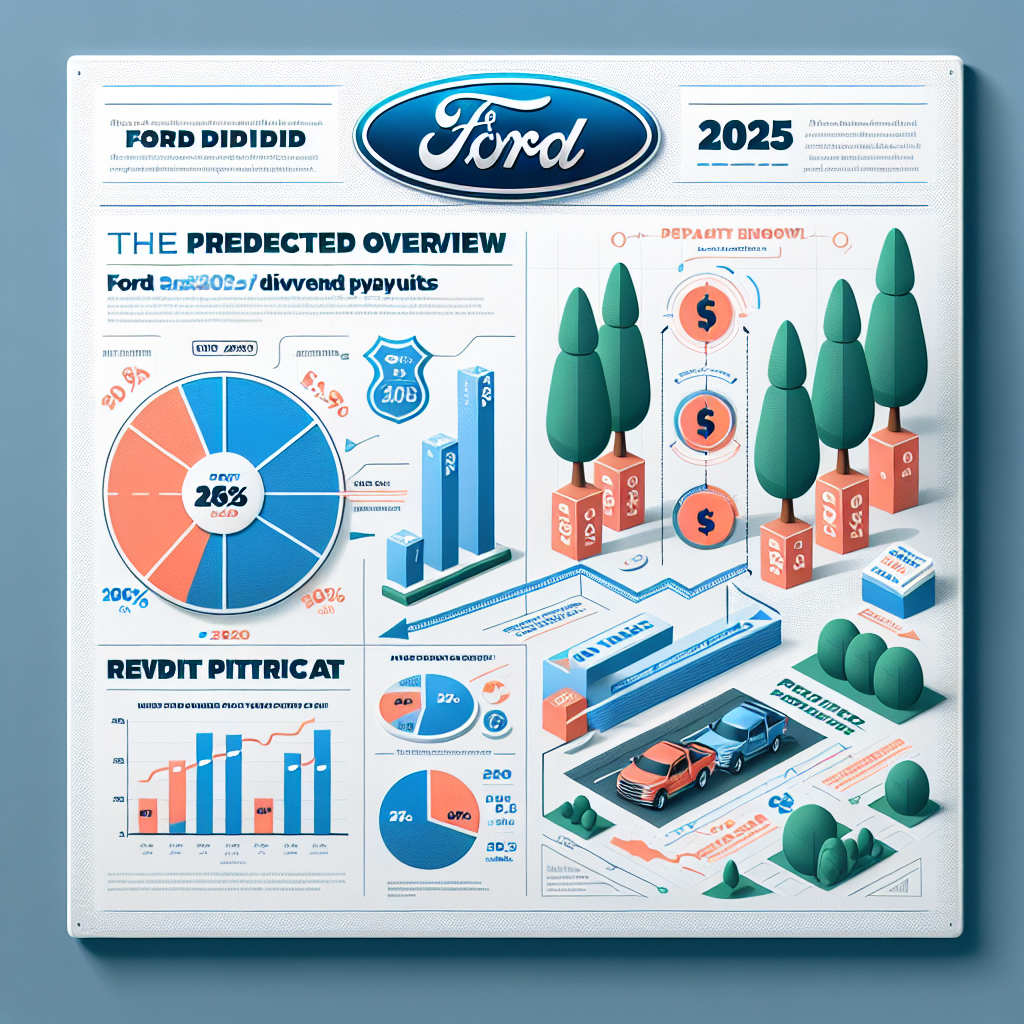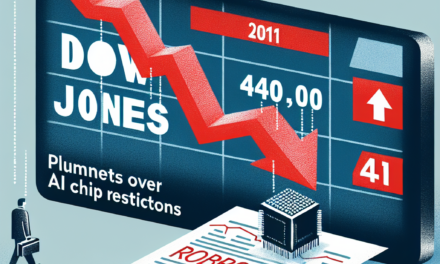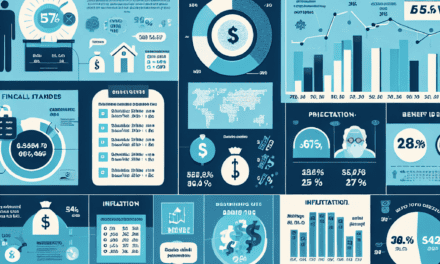“Ford 2025: Driving Dividends Forward with Confidence.”
Introduction
In 2025, Ford Motor Company is poised to navigate a complex financial landscape as it considers its dividend payout strategy. As a major player in the automotive industry, Ford’s dividend decisions are closely watched by investors seeking income stability and growth potential. The company’s financial health, influenced by factors such as global economic conditions, automotive sales performance, and strategic investments in electric vehicles and technology, will play a crucial role in shaping its dividend policy. Additionally, Ford’s commitment to shareholder value and its historical dividend trends provide insights into what investors might expect in terms of dividend payouts in 2025. As the company balances reinvestment in innovation with rewarding shareholders, Ford’s 2025 dividend payout will be a key indicator of its financial strategy and market confidence.
Analyzing Ford’s Financial Health: Implications for 2025 Dividend Payout
As we look towards 2025, Ford Motor Company’s financial health is a topic of considerable interest, particularly for investors keen on understanding the implications for the company’s dividend payout. The automotive giant, with its storied history and significant market presence, has long been a staple in many investment portfolios. However, the rapidly evolving automotive landscape, characterized by the shift towards electric vehicles (EVs) and the integration of advanced technologies, presents both challenges and opportunities for Ford. Consequently, these factors play a crucial role in shaping the company’s financial strategies and, by extension, its dividend policies.
To begin with, Ford’s recent financial performance provides a foundation for assessing its future dividend payouts. Over the past few years, Ford has demonstrated resilience in navigating economic uncertainties, including supply chain disruptions and fluctuating consumer demand. The company’s strategic investments in EVs, such as the development of the Ford Mustang Mach-E and the F-150 Lightning, have positioned it as a formidable competitor in the EV market. These initiatives are not only crucial for revenue growth but also for maintaining investor confidence, which is essential for sustaining dividend payouts.
Moreover, Ford’s commitment to cost management and operational efficiency has been evident in its recent financial reports. The company has undertaken significant restructuring efforts aimed at optimizing its global operations and reducing overhead costs. These measures are expected to enhance Ford’s profitability, thereby providing a more stable financial footing for future dividend distributions. Additionally, Ford’s focus on expanding its market share in key regions, particularly in North America and China, is likely to bolster its revenue streams, further supporting its capacity to maintain or even increase dividend payouts.
However, it is important to consider the potential risks that could impact Ford’s financial health and, consequently, its dividend policy. The automotive industry is currently facing unprecedented challenges, including the transition to sustainable energy sources and the increasing regulatory pressures related to emissions. Ford’s ability to adapt to these changes will be critical in determining its long-term financial stability. Furthermore, the competitive landscape is intensifying, with both traditional automakers and new entrants vying for market share in the EV sector. Ford’s strategic responses to these competitive pressures will significantly influence its financial outcomes and dividend decisions.
In addition to these industry-specific factors, broader economic conditions will also play a role in shaping Ford’s dividend policy. Macroeconomic variables such as interest rates, inflation, and consumer spending patterns can have a profound impact on the automotive market. Ford’s management will need to carefully navigate these external factors to ensure the company’s financial resilience and its ability to deliver consistent returns to shareholders.
In conclusion, while Ford’s recent financial performance and strategic initiatives provide a positive outlook for its 2025 dividend payout, several uncertainties remain. The company’s success in executing its EV strategy, managing operational costs, and responding to competitive and regulatory challenges will be pivotal in determining its financial health. Investors should closely monitor these developments, as they will have significant implications for Ford’s dividend policy in the coming years. Ultimately, Ford’s ability to balance growth opportunities with financial prudence will be key to sustaining its dividend payouts and maintaining investor confidence.
Historical Trends in Ford’s Dividend Payouts: What They Tell Us About 2025
Ford Motor Company, a stalwart in the automotive industry, has long been a subject of interest for investors, particularly those focused on dividend income. Understanding the historical trends in Ford’s dividend payouts provides valuable insights into what stakeholders might anticipate for 2025. Over the years, Ford’s approach to dividends has been shaped by a combination of market conditions, company performance, and strategic priorities. By examining these factors, we can better gauge the potential trajectory of Ford’s dividend policy in the near future.
Historically, Ford has demonstrated a commitment to returning value to its shareholders through dividends, albeit with some fluctuations. In the early 2000s, Ford’s dividend payouts were relatively stable, reflecting a period of consistent profitability. However, the financial crisis of 2008 marked a turning point, as the company was forced to suspend its dividend to preserve cash amid economic uncertainty. This decision, while difficult, underscored Ford’s pragmatic approach to financial management, prioritizing long-term stability over short-term shareholder returns.
As the economy recovered, Ford reinstated its dividend in 2012, signaling renewed confidence in its financial health. This move was well-received by investors, as it indicated a return to profitability and a commitment to sharing success with shareholders. In the years that followed, Ford gradually increased its dividend payouts, aligning them with its improving financial performance. This period of growth was characterized by strategic investments in new technologies and global expansion, which bolstered the company’s revenue streams and supported its dividend policy.
However, the onset of the COVID-19 pandemic in 2020 once again tested Ford’s resilience. Faced with unprecedented challenges, the company made the difficult decision to suspend its dividend to conserve cash and navigate the uncertain landscape. This move, while disappointing to some investors, was a prudent measure that allowed Ford to focus on operational efficiency and strategic priorities during a tumultuous time. By 2021, as the global economy began to stabilize, Ford resumed its dividend payments, albeit at a reduced rate, reflecting a cautious yet optimistic outlook.
Looking ahead to 2025, several factors will likely influence Ford’s dividend policy. First and foremost, the company’s financial performance will be a critical determinant. As Ford continues to invest in electric vehicles and autonomous driving technologies, its ability to generate sustainable profits will be paramount. Additionally, macroeconomic conditions, such as interest rates and inflation, will play a role in shaping Ford’s dividend strategy. A stable economic environment could provide the company with the confidence to increase its payouts, while volatility might necessitate a more conservative approach.
Moreover, Ford’s strategic priorities will also impact its dividend decisions. As the automotive industry undergoes a significant transformation, Ford’s focus on innovation and sustainability will require substantial capital investment. Balancing these investments with shareholder returns will be a delicate task, requiring careful consideration of both short-term and long-term objectives.
In conclusion, while historical trends in Ford’s dividend payouts offer valuable insights, predicting the exact nature of its 2025 dividend policy remains complex. The interplay of financial performance, economic conditions, and strategic priorities will ultimately shape Ford’s approach. Nevertheless, the company’s track record of adapting to changing circumstances and its commitment to shareholder value suggest that Ford will continue to navigate these challenges with prudence and foresight. As such, investors can remain cautiously optimistic about the potential for dividend growth in the coming years.
Market Predictions: Expert Opinions on Ford’s 2025 Dividend Strategy
As the automotive industry continues to evolve, investors are keenly observing how major players like Ford Motor Company will navigate the financial landscape, particularly in terms of dividend payouts. With the year 2025 on the horizon, market analysts are offering varied predictions regarding Ford’s dividend strategy, taking into account the company’s recent performance, industry trends, and broader economic factors. Understanding these predictions requires a comprehensive look at both Ford’s current financial health and the external pressures that may influence its future decisions.
To begin with, Ford’s recent financial performance provides a foundational context for any predictions about its 2025 dividend strategy. Over the past few years, Ford has demonstrated resilience in the face of significant challenges, including supply chain disruptions and the global shift towards electric vehicles (EVs). The company’s strategic investments in EV technology and infrastructure have positioned it as a formidable competitor in the burgeoning electric market. Consequently, Ford’s financial statements have shown a steady recovery, with increasing revenues and a commitment to cost management. This financial stability is a crucial factor that experts consider when forecasting potential dividend payouts.
Moreover, the automotive industry’s transition towards sustainability and innovation plays a pivotal role in shaping Ford’s dividend strategy. As the company allocates substantial resources to develop its EV lineup, it must balance these investments with shareholder expectations for dividends. Analysts suggest that Ford’s ability to maintain or increase its dividend payouts will largely depend on the success of its EV initiatives. If Ford can capture a significant market share in the EV sector, it may generate sufficient profits to support robust dividend payments. Conversely, any setbacks in this area could necessitate a more conservative approach to dividends.
In addition to industry-specific factors, broader economic conditions will inevitably influence Ford’s dividend decisions. The global economy is currently experiencing a period of uncertainty, with inflationary pressures and fluctuating interest rates posing potential challenges. These economic variables can impact consumer spending and, by extension, automotive sales. Should economic conditions remain volatile, Ford may opt to prioritize financial flexibility over aggressive dividend increases, ensuring it can weather any economic downturns without compromising its long-term strategic goals.
Furthermore, expert opinions also highlight the importance of Ford’s corporate governance and its commitment to shareholder value. The company’s leadership has historically demonstrated a balanced approach to capital allocation, striving to reward shareholders while investing in future growth. This dual focus is likely to continue influencing Ford’s dividend strategy in 2025. Analysts anticipate that Ford will aim to strike a balance between providing attractive returns to shareholders and retaining sufficient capital to fund its ambitious growth plans.
In conclusion, while predicting Ford’s exact dividend payout for 2025 involves a degree of speculation, several key factors provide insight into potential outcomes. The company’s financial health, strategic focus on electric vehicles, prevailing economic conditions, and corporate governance practices all play integral roles in shaping its dividend strategy. As Ford navigates these complex dynamics, investors can expect a carefully considered approach that seeks to balance immediate shareholder returns with long-term growth objectives. Ultimately, Ford’s ability to adapt to industry changes and economic challenges will be crucial in determining the trajectory of its dividend payouts in the coming years.
Impact of Electric Vehicle Expansion on Ford’s 2025 Dividend Payout

As the automotive industry undergoes a transformative shift towards electrification, Ford Motor Company stands at the forefront of this evolution, poised to make significant strides in the electric vehicle (EV) market. This strategic pivot towards EVs is not only reshaping Ford’s product lineup but also influencing its financial strategies, including dividend payouts. Investors and stakeholders are keenly observing how Ford’s commitment to electric vehicles will impact its 2025 dividend payout, a crucial aspect of shareholder returns.
To understand the potential impact of Ford’s EV expansion on its dividend payout, it is essential to consider the company’s substantial investments in electric vehicle technology and infrastructure. Ford has announced plans to allocate over $30 billion towards EV development by 2025, a move that underscores its dedication to becoming a leader in the electric vehicle sector. This significant capital expenditure is expected to enhance Ford’s competitive edge, enabling it to capture a larger market share in the burgeoning EV market. However, such a substantial financial commitment also raises questions about the availability of funds for dividend distributions.
In the short term, Ford’s aggressive investment in EVs may exert pressure on its cash flow, potentially affecting its ability to maintain or increase dividend payouts. The company must balance the need to fund its EV initiatives with the expectations of its shareholders, who have traditionally relied on dividends as a source of income. Nevertheless, Ford’s management has expressed confidence in its ability to sustain dividend payments, citing robust financial performance and a strong balance sheet as key factors that will support its dividend policy.
Moreover, the anticipated growth in EV sales could eventually bolster Ford’s revenue streams, thereby enhancing its capacity to distribute dividends. As consumer demand for electric vehicles continues to rise, Ford’s expanded EV portfolio is expected to drive significant revenue growth. This, in turn, could lead to increased profitability, providing the company with greater financial flexibility to reward its shareholders through dividends. Additionally, Ford’s strategic partnerships and collaborations in the EV space are likely to yield synergies and cost efficiencies, further strengthening its financial position.
Furthermore, Ford’s commitment to sustainability and innovation is expected to enhance its brand value and market reputation, attracting a broader investor base. This increased investor interest could positively influence Ford’s stock performance, indirectly supporting its dividend payout strategy. As the company solidifies its position in the EV market, it may also explore alternative financing options, such as green bonds, to fund its initiatives without compromising its dividend policy.
In conclusion, while Ford’s ambitious electric vehicle expansion presents certain challenges to its 2025 dividend payout, it also offers significant opportunities for long-term growth and shareholder value creation. The company’s ability to navigate this complex landscape will depend on its strategic execution, financial discipline, and adaptability to evolving market dynamics. As Ford continues to innovate and expand its EV offerings, investors can expect a dynamic interplay between its growth ambitions and dividend commitments. Ultimately, the impact of Ford’s EV expansion on its 2025 dividend payout will hinge on the successful realization of its electrification goals and the broader acceptance of electric vehicles in the global market.
Comparing Ford’s Dividend Payout with Competitors: Insights for 2025
As we look towards 2025, the automotive industry is poised for significant transformations, with companies like Ford navigating a rapidly evolving landscape. One area of interest for investors is the dividend payout, a critical component of shareholder returns. Ford’s dividend strategy, particularly in comparison to its competitors, offers valuable insights into the company’s financial health and strategic priorities. Understanding how Ford’s dividend payout stacks up against its peers provides a clearer picture of what investors might expect in 2025.
Historically, Ford has maintained a commitment to returning value to its shareholders through dividends. This approach has been a cornerstone of its financial strategy, reflecting the company’s confidence in its long-term profitability. However, the automotive industry is currently undergoing a seismic shift towards electrification and digitalization, prompting companies to reassess their capital allocation strategies. In this context, Ford’s dividend policy will likely be influenced by its need to invest in new technologies and infrastructure to remain competitive.
When comparing Ford’s dividend payout with its competitors, it is essential to consider the broader industry trends. Companies like General Motors and Stellantis are also navigating similar challenges and opportunities, each with its unique approach to balancing shareholder returns with necessary investments in innovation. For instance, General Motors has been aggressively investing in electric vehicles (EVs) and autonomous driving technologies, which may impact its dividend payouts. Similarly, Stellantis, formed from the merger of Fiat Chrysler and PSA Group, is focusing on synergies and cost efficiencies, which could influence its dividend strategy.
In this competitive landscape, Ford’s dividend payout will likely reflect its strategic priorities and financial performance. The company’s recent investments in EVs, such as the Ford F-150 Lightning and the Mustang Mach-E, demonstrate its commitment to leading the charge in electrification. These investments, while crucial for future growth, require substantial capital, potentially affecting the funds available for dividends. However, Ford’s management has expressed confidence in its ability to balance these investments with shareholder returns, suggesting that dividends will remain a priority.
Moreover, Ford’s financial performance in the coming years will play a pivotal role in determining its dividend payout. The company’s ability to generate consistent cash flow from its core operations will be crucial in sustaining or even increasing dividends. Factors such as market demand for EVs, supply chain stability, and cost management will significantly influence Ford’s financial health. A strong performance in these areas could enable Ford to maintain a competitive dividend payout relative to its peers.
In conclusion, as we anticipate Ford’s dividend payout in 2025, it is essential to consider the broader industry dynamics and the company’s strategic direction. While the shift towards electrification presents challenges, it also offers opportunities for growth and innovation. Ford’s ability to navigate this transition while maintaining a focus on shareholder returns will be a key determinant of its dividend strategy. By comparing Ford’s approach with that of its competitors, investors can gain valuable insights into the company’s financial priorities and potential for future dividend payouts. As the automotive industry continues to evolve, Ford’s commitment to balancing innovation with shareholder value will be critical in shaping its dividend policy in the years to come.
Investor Expectations: How Ford’s 2025 Dividend Payout Could Affect Stock Prices
As investors look toward 2025, Ford’s anticipated dividend payout is a topic of considerable interest, with potential implications for stock prices. Understanding the dynamics of dividend payouts and their impact on stock valuation is crucial for investors aiming to make informed decisions. Historically, dividend payouts have been a significant factor in attracting and retaining investors, as they provide a tangible return on investment. Ford, a stalwart in the automotive industry, has a long-standing tradition of rewarding its shareholders through dividends, and any changes in this policy could influence investor sentiment and, consequently, stock prices.
In recent years, Ford has navigated a complex landscape marked by technological advancements, regulatory changes, and shifting consumer preferences. The company’s strategic initiatives, including its push towards electric vehicles and autonomous driving technology, have required substantial capital investment. These investments, while essential for long-term growth, can impact the company’s ability to maintain or increase dividend payouts. Therefore, investors are keenly observing how Ford balances its growth ambitions with shareholder returns.
Moreover, the broader economic environment plays a pivotal role in shaping dividend policies. Factors such as interest rates, inflation, and economic growth can influence corporate earnings and, by extension, dividend payouts. In a low-interest-rate environment, for instance, dividends become more attractive to investors seeking yield, potentially driving up demand for dividend-paying stocks like Ford. Conversely, rising interest rates could lead to a reevaluation of dividend stocks as investors seek higher returns elsewhere.
Ford’s financial performance in the lead-up to 2025 will be a critical determinant of its dividend policy. Strong earnings growth and robust cash flow generation would provide the company with the flexibility to increase dividends, thereby enhancing shareholder value. On the other hand, if Ford faces financial headwinds, it may opt to conserve cash, which could result in a stagnant or reduced dividend payout. Such a scenario might lead to a negative reaction from the market, as investors could perceive it as a sign of financial distress or a lack of confidence in future earnings.
Investor expectations regarding Ford’s dividend payout are also shaped by the company’s competitive positioning within the automotive industry. As Ford continues to compete with both traditional automakers and new entrants in the electric vehicle space, its ability to maintain market share and profitability will be closely scrutinized. A strong competitive position could bolster investor confidence, leading to a more favorable outlook for dividend payouts and stock prices.
Furthermore, Ford’s management team plays a crucial role in setting and communicating dividend policy. Transparent communication regarding the company’s financial health, strategic priorities, and dividend intentions can help manage investor expectations and mitigate potential volatility in stock prices. Investors value clarity and consistency, and any perceived ambiguity or inconsistency in dividend policy could lead to uncertainty and increased stock price volatility.
In conclusion, Ford’s 2025 dividend payout is a multifaceted issue that will be influenced by a range of factors, including the company’s financial performance, economic conditions, competitive dynamics, and management’s strategic decisions. As investors assess these variables, they will form expectations that could significantly impact Ford’s stock prices. Therefore, staying informed about Ford’s strategic direction and financial health will be essential for investors seeking to navigate the potential implications of the company’s dividend policy in 2025.
Economic Factors Influencing Ford’s 2025 Dividend Decisions
As Ford Motor Company approaches its 2025 dividend payout, several economic factors will play a crucial role in shaping the company’s decisions. Understanding these factors is essential for investors and stakeholders who are keen on predicting the potential outcomes of Ford’s dividend strategy. To begin with, the global economic environment will significantly influence Ford’s dividend decisions. The automotive industry is highly sensitive to economic cycles, and any fluctuations in global economic growth can impact consumer demand for vehicles. In periods of economic expansion, increased consumer spending typically leads to higher vehicle sales, thereby boosting Ford’s revenues and profitability. Conversely, during economic downturns, reduced consumer spending can lead to a decline in vehicle sales, potentially affecting the company’s ability to maintain or increase dividend payouts.
Moreover, interest rates set by central banks around the world will also affect Ford’s financial performance and, consequently, its dividend decisions. Low interest rates generally reduce the cost of borrowing, enabling Ford to finance its operations and investments more cheaply. This can lead to improved financial health and potentially higher dividend payouts. However, if interest rates rise, the increased cost of borrowing could strain Ford’s financial resources, possibly leading to more conservative dividend policies. Additionally, exchange rate fluctuations can impact Ford’s international operations, as the company generates a significant portion of its revenue from overseas markets. A strong U.S. dollar can make Ford’s products more expensive in foreign markets, potentially reducing sales and affecting profitability. This, in turn, could influence the company’s ability to sustain or enhance its dividend payouts.
Furthermore, the ongoing transition to electric vehicles (EVs) presents both opportunities and challenges for Ford. The company has been investing heavily in EV technology to remain competitive in a rapidly evolving market. While these investments are crucial for long-term growth, they also require substantial capital expenditure, which could impact Ford’s short-term cash flow and dividend decisions. Balancing the need for investment in future technologies with the desire to reward shareholders through dividends will be a key consideration for Ford’s management. In addition to these factors, regulatory changes and government policies related to emissions and environmental standards will also play a role in shaping Ford’s dividend strategy. Stricter regulations may necessitate further investment in cleaner technologies, potentially affecting the company’s financial resources available for dividend payouts.
Moreover, competitive pressures within the automotive industry cannot be overlooked. As traditional automakers and new entrants vie for market share, Ford must continuously innovate and adapt to changing consumer preferences. This competitive landscape may require Ford to allocate more resources towards research and development, which could influence its dividend decisions. Lastly, Ford’s internal financial health, including its balance sheet strength and cash flow generation, will be critical in determining its dividend policy. A strong balance sheet and robust cash flow provide the company with the flexibility to reward shareholders while also investing in growth opportunities. Conversely, any financial constraints could lead to more cautious dividend decisions.
In conclusion, Ford’s 2025 dividend payout will be influenced by a myriad of economic factors, including global economic conditions, interest rates, exchange rates, the transition to electric vehicles, regulatory changes, competitive pressures, and the company’s internal financial health. By carefully navigating these factors, Ford aims to strike a balance between rewarding shareholders and investing in its future growth.
Q&A
1. **What is Ford’s expected dividend payout for 2025?**
Ford has not officially announced its 2025 dividend payout, and future dividends depend on the company’s financial performance and board decisions.
2. **How does Ford determine its dividend payouts?**
Ford’s dividend payouts are typically based on its earnings, cash flow, and overall financial health, as well as strategic priorities set by the board of directors.
3. **What factors could influence Ford’s 2025 dividend payout?**
Factors include the company’s profitability, cash reserves, economic conditions, industry trends, and any strategic investments or debt obligations.
4. **Has Ford historically paid consistent dividends?**
Ford has a history of paying dividends, but the amounts have varied based on financial performance and economic conditions.
5. **What is the current dividend yield for Ford?**
As of the latest data, Ford’s dividend yield fluctuates with its stock price and dividend announcements. Check financial news sources for the most current yield.
6. **How might Ford’s electric vehicle strategy impact its 2025 dividends?**
Investments in electric vehicles could affect cash flow and profitability, potentially influencing dividend decisions depending on the success of these initiatives.
7. **Are there any risks to Ford’s dividend payouts in 2025?**
Risks include economic downturns, increased competition, supply chain disruptions, and any unforeseen financial challenges that could impact earnings.
Conclusion
Ford’s 2025 dividend payout will likely be influenced by several key factors, including the company’s financial performance, strategic priorities, and broader economic conditions. As Ford continues to invest in electric vehicles and other innovative technologies, its capital allocation strategy may prioritize growth and development over dividend increases. However, if the company achieves strong profitability and cash flow, it may maintain or modestly increase its dividend to reward shareholders. Additionally, economic conditions, such as interest rates and consumer demand, will play a crucial role in shaping Ford’s dividend decisions. Overall, while Ford’s commitment to shareholder returns remains, the exact nature of its 2025 dividend payout will depend on balancing growth investments with shareholder expectations.





